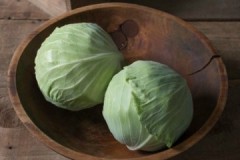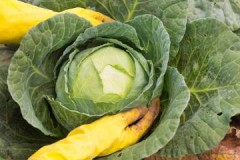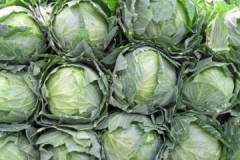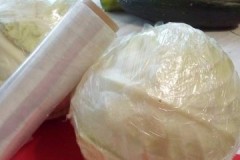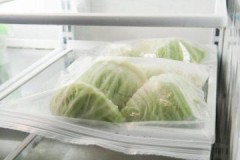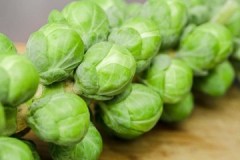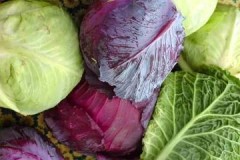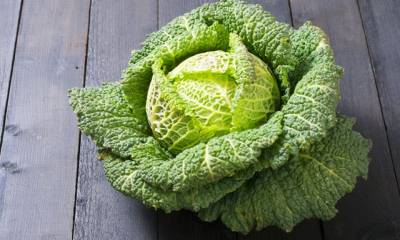 Tasty and juicy cabbage can remain fresh until the weather warms up, but for this you need to store it properly. There are many nuances, from the choice of variety to the selection of suitable containers.
Tasty and juicy cabbage can remain fresh until the weather warms up, but for this you need to store it properly. There are many nuances, from the choice of variety to the selection of suitable containers.
It is enough to successfully master the technology once and in the future you will not have to look for new ways to extend the shelf life of healthy vegetables.
Read the article on how to properly store cabbage in winter.
Content
Preparation for storage
Preparing for storage is not only about cleaning the cabbage from dirt and drying it. It begins in the spring, when choosing a variety.
The best winter varieties
For storage, you need to choose late-ripening cabbage varieties. Harvest in the second half of autumn, with the onset of the first frosts. Such a long stay of a vegetable in the garden hardens it, helps to increase immunity, so it is not afraid of diseases.
 Heads of stored varieties are less juicy, but contain more fiber. Their leaves are veiny, hard and dense. For long-term storage, you can choose the following seeds:
Heads of stored varieties are less juicy, but contain more fiber. Their leaves are veiny, hard and dense. For long-term storage, you can choose the following seeds:
- Snowstorm;
- Snow White;
- Present;
- Dombrovskaya;
- Glory;
- Stolichnaya;
- Harvest, etc.
The shelf life of late-ripening varieties can reach 12 months. List of cabbage varieties for winter storage - Here.
Optimal conditions
Cabbage has certain requirements for storage conditions. Optimal parameters:
- Air temperature – from -1 to +2 degrees.
- Air humidity 85-95%.
Read more about cabbage storage temperature here.
What is the best way to store it: ways
There are several options for storing cabbage, namely:
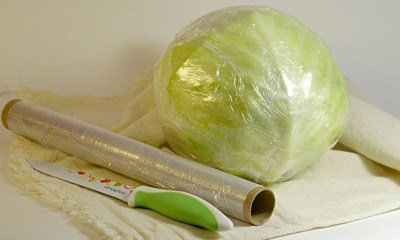 In cling film. To do this, the head of cabbage is wrapped in 2-3 layers so that the polyethylene fits tightly to its surface.
In cling film. To do this, the head of cabbage is wrapped in 2-3 layers so that the polyethylene fits tightly to its surface.- In paper. It acts as an isolate, preventing the forks from touching each other. However, it will have to be changed from time to time, since wet paper is a breeding ground for the growth of bacteria and rot of vegetables.
- In boxes. Preference is given to wooden or plastic containers, with holes between the boards and an open top.
- On wooden pallets. The heads of cabbage are stacked in a pyramid.
- In sand. Place the forks in boxes in layers and then sprinkle them with sand.
- In limbo. This method requires a rope and a beam to which the vegetables will be attached. They are wrapped around the stump, which is not cut off.
- On shelves. The forks are laid out so that they do not touch each other.
The method of storing cabbage in clay has proven itself well. It will take a lot of time to prepare, but the coated heads of cabbage will be stored for at least 7-8 months. Place them in boxes or on shelves.
When to put it away for storage?
If remove the heads of cabbage for storage too early, the vegetables will wilt. Delaying the torque will cause cracks in the forks.
Therefore, you need to follow several rules:
- Harvesting begins when the air temperature during the daytime is +3...+8 degrees, and at night drops to 0...-3 degrees.
- The weather should be dry. When it rains, forks are not cut off.
- After harvesting, the heads of cabbage are dried in a warm room with good ventilation, or outside under a canopy.
Process Features
It is wrong to think that cabbage can only be stored in the cellar, although this is where ideal conditions have been created for it. In fact, vegetables overwinter on the balcony, in the refrigerator, in garages. Sometimes they are even buried in the ground.
At home
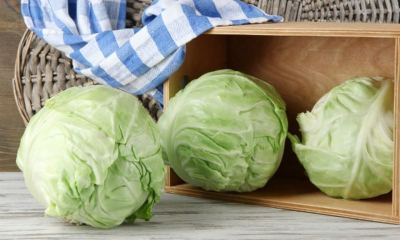 You can store cabbage at home in a refrigerator, in the vegetable shelf. However, it will not be possible to place more than 2-4 forks in the box.
You can store cabbage at home in a refrigerator, in the vegetable shelf. However, it will not be possible to place more than 2-4 forks in the box.
You can freeze cauliflower and savoy cabbage White cabbage is placed in the freezer only after pre-processing: stewed or pickled.
Fresh heads of cabbage do not tolerate sudden cooling; after thawing, their leaves become soft and lose their taste. If you leave cabbage in your apartment, it will begin to spoil within 7-9 days.
Another place to store fresh forks is the balcony. It must be glazed. Otherwise, the vegetables will freeze. On the loggia they are stored in foam-insulated boxes, which are covered with blankets or old jackets on top.
An important condition for storing cabbage on the balcony is maintaining a stable temperature. If constant changes occur, the vegetables will quickly begin to deteriorate. Read more Here.
In the cellar or basement
You can store cabbage in the cellar or basement until it warms up. The room must be clean and ventilated once a month. Place the heads of cabbage in any available way: hang them by stumps or put them in boxes.
In winter, you need to periodically check your vegetables. If signs of rot are found, spoiled specimens are removedso that they do not infect healthy vegetables. Read more about storing cabbage in the cellar here.
In the garage
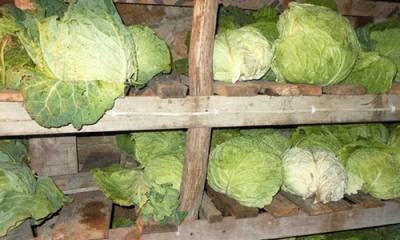 If the garage does not have a cellar, you can simply store cabbage on shelves or racks.
If the garage does not have a cellar, you can simply store cabbage on shelves or racks.
An unheated room freezes, so heads of cabbage should be placed as high as possible from the floor. They must be wrapped in film and covered with blankets.
If the garage is heated, then you can lay out the cabbage on racks 20-30 cm high from the floor. Another option is to hang vegetables by their roots. It is necessary to ensure that the air temperature in the room does not rise above +8 degrees. Otherwise, the heads of cabbage will not go into “sleep mode” and will quickly deteriorate.
Polyethylene film helps protect vegetables from moisture loss, since it is difficult to achieve 95% air humidity in a garage.
In a pit in winter
If you protect vegetables from moisture and pests, and provide good ventilation, they will be stored well in the ground.
Features of laying vegetables in a hole:
- In a suitable place, dig a trench 60 cm deep and 40 cm wide.
- The bottom of the pit is sprinkled with sand, and several poles are placed on top.
- The forks are placed in a trench in 1-2 layers, with the stumps facing up.
- Every 3 m a tube is installed that will provide ventilation to the pit.
- Fill the hole with sand or dry straw. In this case, you need to make sure that the material does not get into the tube.
- The top of the trench is sprinkled with a layer of clay 10 cm thick, after which up to 20 cm of soil is added. The clay will prevent moisture from penetrating inside, and the soil will protect the forks from frost.
- Additionally, the trench is covered with roofing felt or slate, making sure that the ventilation holes remain open.
- When enough snow has fallen, it is thrown over the trench to improve its thermal insulation.
Rules for different types of vegetables
Depending on the type of vegetables, their storage conditions will differ. For example, Chinese cabbage remains fresh in the refrigerator for several months, pickled vegetables are best rolled under a metal lid, and cauliflower is recommended to be frozen.
Beijing
Features of storing Beijing cabbage:
 Before storing vegetables in the refrigerator, they are wrapped in plastic. In this form, it remains fresh for up to 3-5 months.
Before storing vegetables in the refrigerator, they are wrapped in plastic. In this form, it remains fresh for up to 3-5 months.- The storage temperature should not exceed +4 degrees to prevent vegetables from sprouting and spoiling.
- Beijing cabbage can be frozen. It is washed, dried, chopped, or divided into leaves and put in the freezer. In such conditions, it remains fresh for more than 6-8 months.
The leaves can be cut into strips and dried in a dryer or oven, and housewives also ferment Chinese cabbage and store it in jars (in the cellar or in the refrigerator).He will tell you about storing Chinese cabbage this article.
Savoy
Savoy is stored in the same way as white cabbage:
- in the cellar;
- in a refrigerator;
- on the balcony.
Before storing, it is cleared of soil, wrapped in plastic wrap and laid so that the forks do not touch each other.
Sauerkraut
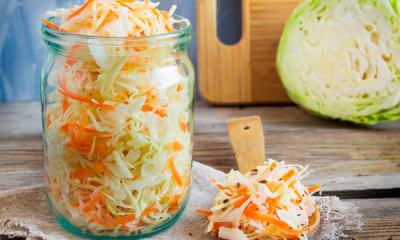 Sauerkraut should be kept in a cool place. In the heat it will quickly deteriorate and ferment.
Sauerkraut should be kept in a cool place. In the heat it will quickly deteriorate and ferment.
Main storage methods:
- In the cellar.
- In the refrigerator: in the main compartment or in the freezer.
- On the balcony.
Sauerkraut is not afraid of freezing; low temperatures do not affect its taste. Therefore, the product can be left to winter even on an unglazed balcony.
The main thing is to avoid temperature changes. Once thawed, cabbage cannot be re-frozen. All about storing sauerkraut - Here.
Color
Cauliflower can be stored in the freezer. This does not affect its benefits and taste. No special preparation is required.
The heads are divided into inflorescences, washed and packaged in plastic bags, which are put into the freezer. At temperatures around 0 degrees, cabbage is stored in a cellar or basement.
You will find all the most important information about storing cauliflower in this section.
Stewed
Stewed cabbage, prepared for future use, is perfectly stored in the freezer.To do this, it needs to be cooled and placed in a convenient container, for example, in plastic bags or plastic containers.
Stewed vegetables can last up to six months in the freezer. You can heat the dish in the microwave or in a frying pan. Due to exposure to cold, the taste of the product does not change. Read more here.
Brussels
Brussels sprouts stored in one of the following ways:
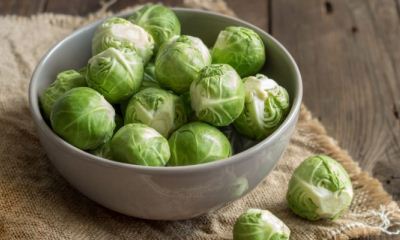 Fresh in the cellar or basement. You can hang vegetables by their stems by removing the top leaves.
Fresh in the cellar or basement. You can hang vegetables by their stems by removing the top leaves.- Another option is to dig up the heads of cabbage and plant them in a box with moistened soil. The air temperature should remain in the range of +3...+5 degrees.
- Freezing allows you to preserve all the beneficial properties of small forks and extend their shelf life to 10 months.
- Pickling or salting as a storage method is suitable for housewives who like to make preparations.
Brussels sprouts are delicious in any form. It is eaten fresh, boiled and pickled. Read more about storing Brussels sprouts Here.
How long can it be stored fresh?
Shelf life of cabbage under various storage conditions:
- In the cellar, outdoors – up to 3 months.
- In plastic film at 0 degrees – up to 6-8 months.
- In a pit - up to 10 months.
- In the refrigerator - up to 3 months.
- At room temperature - up to 10 days.
How to choose the right neighbors?
There are vegetables that cabbage is “friends” with, so they can be placed in close proximity. These include:
- potato;
- beet;
- carrot;
- radish;
- pumpkin.
The main rule is not to store cabbage next to apples. It is advisable that they are not in the room at all. Apples emit gas that speeds up the ripening of other vegetables and fruits, causing them to spoil quickly.
Possible problems and ways to overcome them
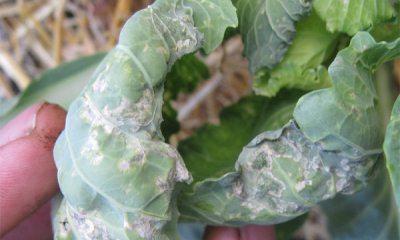 If the cabbage begins to rot, remove the top spoiled leaves and powder the heads with crushed chalk. As a rule, the spoilage process is slowed down, but such forks need to be stored separately from the rest of the harvest.
If the cabbage begins to rot, remove the top spoiled leaves and powder the heads with crushed chalk. As a rule, the spoilage process is slowed down, but such forks need to be stored separately from the rest of the harvest.
If the leaves wither, it means there is low humidity in the room.. You can increase it if you place containers of water in the cellar.
Sometimes a large amount of concentrate forms under the film, which is an ideal environment for the growth of bacteria. Most often this happens because the heads of cabbage were wrapped warm and then put in a cold place.
Water is a consequence of temperature changes. Dealing with the problem is simple; just remove the old film and replace it with a new one.
Conclusion
Storing cabbage is a simple process if you know and follow certain conditions. To keep the forks fresh for as long as possible, you need to maintain the air temperature at about 0 degrees and the humidity at 90%. The room should be clean, and the forks themselves should not be pressed tightly against each other.
